Archive for October, 2009
DC Trip pictures
So, since I have been so terrible about writing about our first field trip, here are some photos from our incredible trip yesterday:
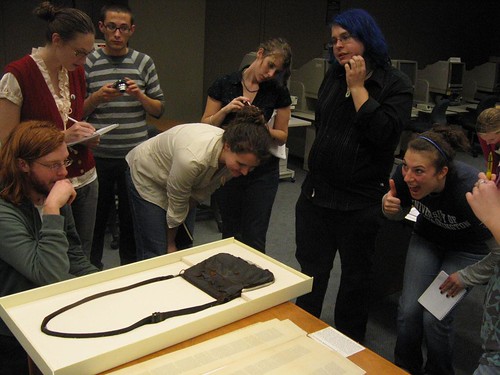
The centerpiece of our LoC tour!
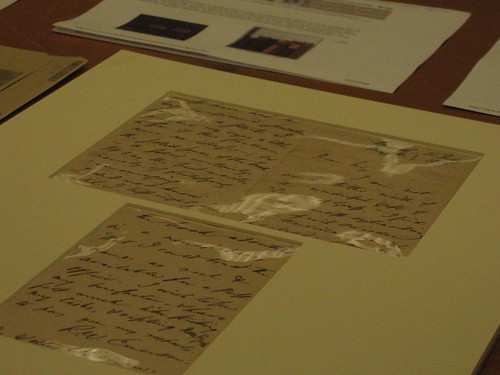
Emerson’s letter to Whitman about the 1855 edition
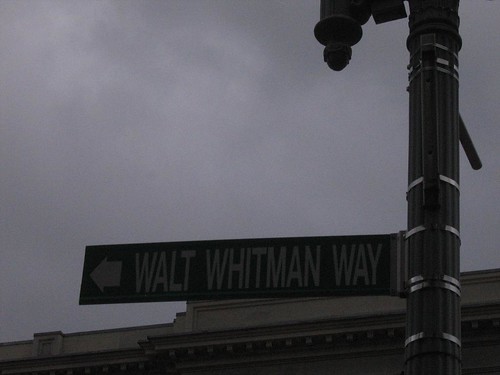
Nuff said
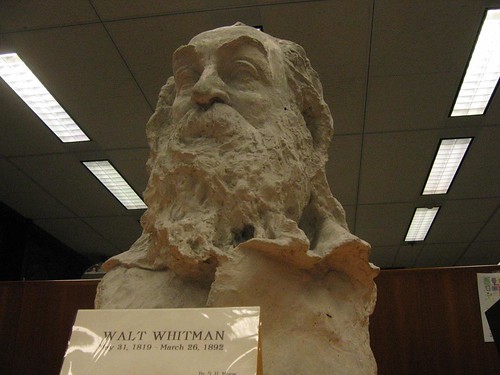
The good, gray poet
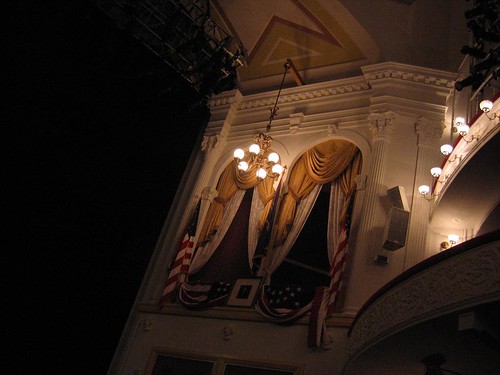
Lincoln’s fateful box seat
DC Trip pictures
So, since I have been so terrible about writing about our first field trip, here are some photos from our incredible trip yesterday:

The centerpiece of our LoC tour!

Emerson’s letter to Whitman about the 1855 edition

Nuff said

The good, gray poet

Lincoln’s fateful box seat
DC Trip pictures
So, since I have been so terrible about writing about our first field trip, here are some photos from our incredible trip yesterday:

The centerpiece of our LoC tour!

Emerson’s letter to Whitman about the 1855 edition

Nuff said

The good, gray poet

Lincoln’s fateful box seat
D.C. Field Trip: My Grumpy Saga
Quick Overview:
- Yesterday I left my house at 10am and did not return until 9:30pm.
- Rain.
- Wind.
- Lots of walking.
- Exhaustion.
- Grumpiness.
- Nap in Ford’s Theater.
- Library of Congress was awesome.
At 11am we began our walking tour that took us around to the places that Walt Whitman worked at and wrote about, i.e. The U.S. Treasury Building (formerly the Attorney General’s Office where Walt Worked), The Willard Hotel (where Walt occasionally visited and now there hangs a sketch of him in the bar), and The White House and Ford’s Theater (feeding into Walt’s super-man-crush on Lincoln). The highlight of the walking tour, at least for me, was Walt Whitman Way, which is between 7th and 8th streets on F. This is where Walt worked at the Patent Office (now the Smithsonian Portrait Gallery) and had previously tended to soldiers in this same building, and also lived in various boarding houses around the same area.

This image is from flickr, and most certainly not taken the day we were there– note the blue sky.
After a lunch break, we all went to Ford’s Theater. At this time I was at the precipice of grumpiness and tiredness. Here’s a brief overview of what interested me:
- John Wilkes Booth’s actual gun used to assassinate Lincoln.
- The Ranger who spoke to us looked like Drew Carey.
- The inside of my eyelids.
And that’s all I got.
Then, lots more walking in the rain. A quick trip into the Starbucks that used to be Alexander Gardner’s daguerreotype studio (shout out to Matthew Brady!) and then on to The Library of Congress. Here’s where I, and it seemed like everyone else, came alive.
HOW FREAKIN’ COOL!
To see the actual sheets of paper with Walt’s handwriting scrawled on it, his little edits in the margins, to see his letters the same way his recipients saw them– amazing! Of course, the piece de resistance was Whitman’s leather messenger bag, now falling apart and preserved in a special box, revealed to a crowd of gaping mouths, sounds of shock, and a couple sets of teary eyes. Plenty of pictures to come of this bag, we were like the paparazzi catching sight of Paris Hilton with that thing. It was truly incredible to see what the Library of Congress has preserved: locks of both Peter Doyle’s and Whitman’s hair, George Whitman’s small diary, Whitman’s journals from the hospitals, Whitman’s eye glasses, his cane, his pen, a cast of his hand, and lots more. It was overwhelming. Sam Protich, at some point, said excitedly, “this is awesome! Who gets to study like this?!” And of all the many intelligent, insightful, some times long winded, comments I have heard Sam make, this one is the most profound to me.
I’ll admit that I complain about my “Walt Whitman Class” all the time, to the extent that my friends call him my “Needy Boyfriend” because I spend so much time “doing” him, but I’m going to keep it real for a second: I love this class. Yes, it’s a lot of work. Yes, I was extremely tried, cold, hungry, and grumpy during our field trip. However, walking away from the Library of Congress, I felt good. I felt enriched. This class is not only worth my tuition money, but worth my time and mental vigor. I am actually learning. And I like it.
Reflecting on this feeling of “good” and enrichment, my mind was drawn to Paulo Freire’s essay “The Banking Concept of Education” (shout out to Jim Groom). Freire’s essay describes how limiting education can be, how the teacher/professor can fall into a pattern of narration, while the students become “containers” that mechanically memorize facts and promptly forget them after spewing them out on a test: “Education thus becomes an act of depositing, in which the students are the depositories and the teacher is the depositor.” This, sadly, is the mode of education that is most familiar to us. However, this course breaks that mold, nay it shatters it! What we have developed in this class is what Freire calls “authentic thinking,” which, “does not take place in ivory tower isolation, but only in communication.” Communication is our middle name; in class, students are speaking 80%-90% of the time. We are physically connecting to what we’re learning about. Instead of mindlessly “consuming” Whitman’s letters, we went out and saw them, were inches away from them. The reason we all feel personally connected to Walt Whitman is because he has become more than information and we have become more than “containers.” This is what it feels like to be a student.
Along with their comments about Whitman being my boyfriend, my friends will joke, “wow, you’re going to be, like, an expert on Whitman by the end of this semester.” To which I respond (not-jokingly), “yeah. I f–in’ will.”
D.C. Field Trip: My Grumpy Saga
Quick Overview:
- Yesterday I left my house at 10am and did not return until 9:30pm.
- Rain.
- Wind.
- Lots of walking.
- Exhaustion.
- Grumpiness.
- Nap in Ford’s Theater.
- Library of Congress was awesome.
At 11am we began our walking tour that took us around to the places that Walt Whitman worked at and wrote about, i.e. The U.S. Treasury Building (formerly the Attorney General’s Office where Walt Worked), The Willard Hotel (where Walt occasionally visited and now there hangs a sketch of him in the bar), and The White House and Ford’s Theater (feeding into Walt’s super-man-crush on Lincoln). The highlight of the walking tour, at least for me, was Walt Whitman Way, which is between 7th and 8th streets on F. This is where Walt worked at the Patent Office (now the Smithsonian Portrait Gallery) and had previously tended to soldiers in this same building, and also lived in various boarding houses around the same area.

This image is from flickr, and most certainly not taken the day we were there– note the blue sky.
After a lunch break, we all went to Ford’s Theater. At this time I was at the precipice of grumpiness and tiredness. Here’s a brief overview of what interested me:
- John Wilkes Booth’s actual gun used to assassinate Lincoln.
- The Ranger who spoke to us looked like Drew Carey.
- The inside of my eyelids.
And that’s all I got.
Then, lots more walking in the rain. A quick trip into the Starbucks that used to be Alexander Gardner’s daguerreotype studio (shout out to Matthew Brady!) and then on to The Library of Congress. Here’s where I, and it seemed like everyone else, came alive.
HOW FREAKIN’ COOL!
To see the actual sheets of paper with Walt’s handwriting scrawled on it, his little edits in the margins, to see his letters the same way his recipients saw them– amazing! Of course, the piece de resistance was Whitman’s leather messenger bag, now falling apart and preserved in a special box, revealed to a crowd of gaping mouths, sounds of shock, and a couple sets of teary eyes. Plenty of pictures to come of this bag, we were like the paparazzi catching sight of Paris Hilton with that thing. It was truly incredible to see what the Library of Congress has preserved: locks of both Peter Doyle’s and Whitman’s hair, George Whitman’s small diary, Whitman’s journals from the hospitals, Whitman’s eye glasses, his cane, his pen, a cast of his hand, and lots more. It was overwhelming. Sam Protich, at some point, said excitedly, “this is awesome! Who gets to study like this?!” And of all the many intelligent, insightful, some times long winded, comments I have heard Sam make, this one is the most profound to me.
I’ll admit that I complain about my “Walt Whitman Class” all the time, to the extent that my friends call him my “Needy Boyfriend” because I spend so much time “doing” him, but I’m going to keep it real for a second: I love this class. Yes, it’s a lot of work. Yes, I was extremely tried, cold, hungry, and grumpy during our field trip. However, walking away from the Library of Congress, I felt good. I felt enriched. This class is not only worth my tuition money, but worth my time and mental vigor. I am actually learning. And I like it.
Reflecting on this feeling of “good” and enrichment, my mind was drawn to Paulo Freire’s essay “The Banking Concept of Education” (shout out to Jim Groom). Freire’s essay describes how limiting education can be, how the teacher/professor can fall into a pattern of narration, while the students become “containers” that mechanically memorize facts and promptly forget them after spewing them out on a test: “Education thus becomes an act of depositing, in which the students are the depositories and the teacher is the depositor.” This, sadly, is the mode of education that is most familiar to us. However, this course breaks that mold, nay it shatters it! What we have developed in this class is what Freire calls “authentic thinking,” which, “does not take place in ivory tower isolation, but only in communication.” Communication is our middle name; in class, students are speaking 80%-90% of the time. We are physically connecting to what we’re learning about. Instead of mindlessly “consuming” Whitman’s letters, we went out and saw them, were inches away from them. The reason we all feel personally connected to Walt Whitman is because he has become more than information and we have become more than “containers.” This is what it feels like to be a student.
Along with their comments about Whitman being my boyfriend, my friends will joke, “wow, you’re going to be, like, an expert on Whitman by the end of this semester.” To which I respond (not-jokingly), “yeah. I f–in’ will.”
D.C. Field Trip: My Grumpy Saga
Quick Overview:
- Yesterday I left my house at 10am and did not return until 9:30pm.
- Rain.
- Wind.
- Lots of walking.
- Exhaustion.
- Grumpiness.
- Nap in Ford’s Theater.
- Library of Congress was awesome.
At 11am we began our walking tour that took us around to the places that Walt Whitman worked at and wrote about, i.e. The U.S. Treasury Building (formerly the Attorney General’s Office where Walt Worked), The Willard Hotel (where Walt occasionally visited and now there hangs a sketch of him in the bar), and The White House and Ford’s Theater (feeding into Walt’s super-man-crush on Lincoln). The highlight of the walking tour, at least for me, was Walt Whitman Way, which is between 7th and 8th streets on F. This is where Walt worked at the Patent Office (now the Smithsonian Portrait Gallery) and had previously tended to soldiers in this same building, and also lived in various boarding houses around the same area.

This image is from flickr, and most certainly not taken the day we were there– note the blue sky.
After a lunch break, we all went to Ford’s Theater. At this time I was at the precipice of grumpiness and tiredness. Here’s a brief overview of what interested me:
- John Wilkes Booth’s actual gun used to assassinate Lincoln.
- The Ranger who spoke to us looked like Drew Carey.
- The inside of my eyelids.
And that’s all I got.
Then, lots more walking in the rain. A quick trip into the Starbucks that used to be Alexander Gardner’s daguerreotype studio (shout out to Matthew Brady!) and then on to The Library of Congress. Here’s where I, and it seemed like everyone else, came alive.
HOW FREAKIN’ COOL!
To see the actual sheets of paper with Walt’s handwriting scrawled on it, his little edits in the margins, to see his letters the same way his recipients saw them– amazing! Of course, the piece de resistance was Whitman’s leather messenger bag, now falling apart and preserved in a special box, revealed to a crowd of gaping mouths, sounds of shock, and a couple sets of teary eyes. Plenty of pictures to come of this bag, we were like the paparazzi catching sight of Paris Hilton with that thing. It was truly incredible to see what the Library of Congress has preserved: locks of both Peter Doyle’s and Whitman’s hair, George Whitman’s small diary, Whitman’s journals from the hospitals, Whitman’s eye glasses, his cane, his pen, a cast of his hand, and lots more. It was overwhelming. Sam Protich, at some point, said excitedly, “this is awesome! Who gets to study like this?!” And of all the many intelligent, insightful, some times long winded, comments I have heard Sam make, this one is the most profound to me.
I’ll admit that I complain about my “Walt Whitman Class” all the time, to the extent that my friends call him my “Needy Boyfriend” because I spend so much time “doing” him, but I’m going to keep it real for a second: I love this class. Yes, it’s a lot of work. Yes, I was extremely tried, cold, hungry, and grumpy during our field trip. However, walking away from the Library of Congress, I felt good. I felt enriched. This class is not only worth my tuition money, but worth my time and mental vigor. I am actually learning. And I like it.
Reflecting on this feeling of “good” and enrichment, my mind was drawn to Paulo Freire’s essay “The Banking Concept of Education” (shout out to Jim Groom). Freire’s essay describes how limiting education can be, how the teacher/professor can fall into a pattern of narration, while the students become “containers” that mechanically memorize facts and promptly forget them after spewing them out on a test: “Education thus becomes an act of depositing, in which the students are the depositories and the teacher is the depositor.” This, sadly, is the mode of education that is most familiar to us. However, this course breaks that mold, nay it shatters it! What we have developed in this class is what Freire calls “authentic thinking,” which, “does not take place in ivory tower isolation, but only in communication.” Communication is our middle name; in class, students are speaking 80%-90% of the time. We are physically connecting to what we’re learning about. Instead of mindlessly “consuming” Whitman’s letters, we went out and saw them, were inches away from them. The reason we all feel personally connected to Walt Whitman is because he has become more than information and we have become more than “containers.” This is what it feels like to be a student.
Along with their comments about Whitman being my boyfriend, my friends will joke, “wow, you’re going to be, like, an expert on Whitman by the end of this semester.” To which I respond (not-jokingly), “yeah. I f–in’ will.”
field trip_fulton ferry landing
flow on, river! flow
with the flood-tide. and
ebb with ebb-tide!
frolic on, crested and
scallop-edg’d waves!
gorgeous clouds of the
sunset! drench with your
splendor me, or the men
and women generations
after me! cross from shore
to shore, countless crowds
of passengers! stand up,
tall masts of mannahatta!
stand up, beautiful
hills of brooklyn!
throb, baffled and
curious brain! throw out
questions and answers!
-walt whitman-
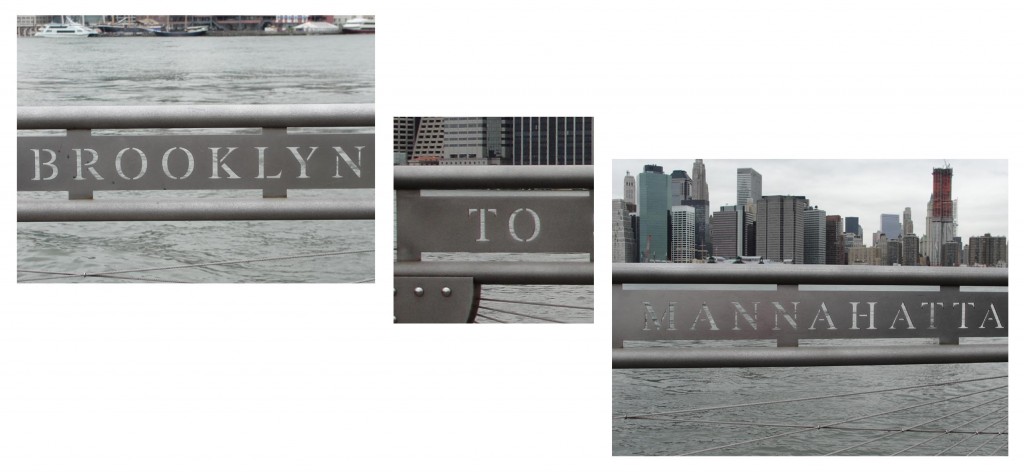
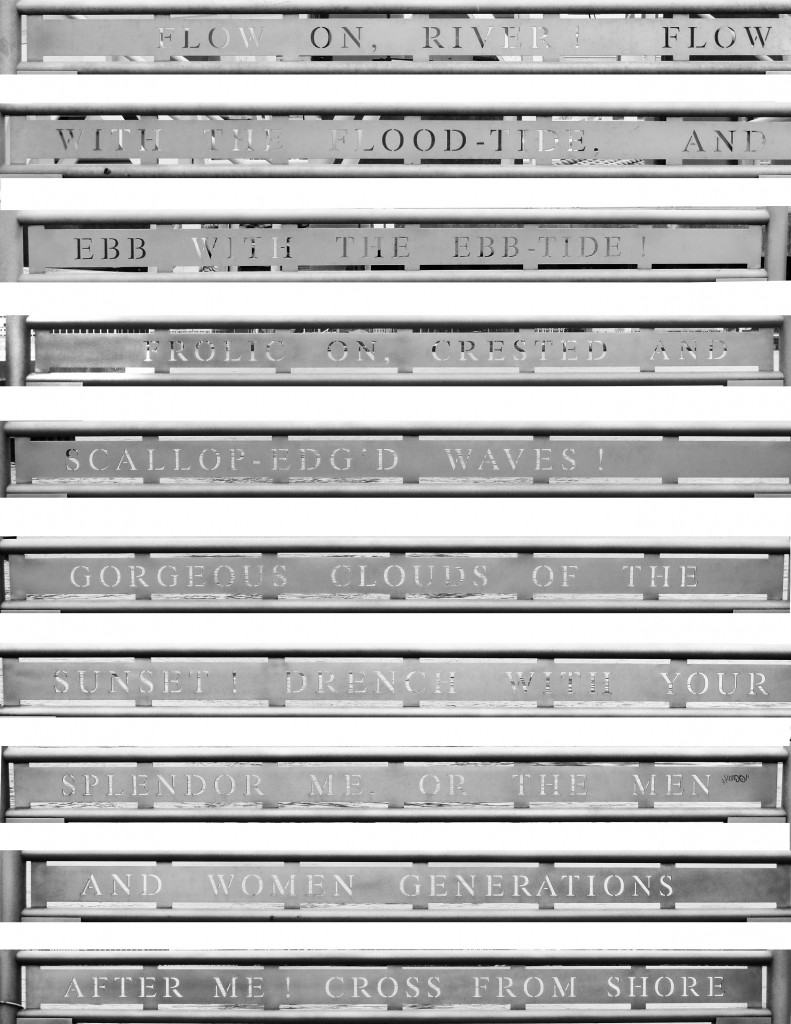
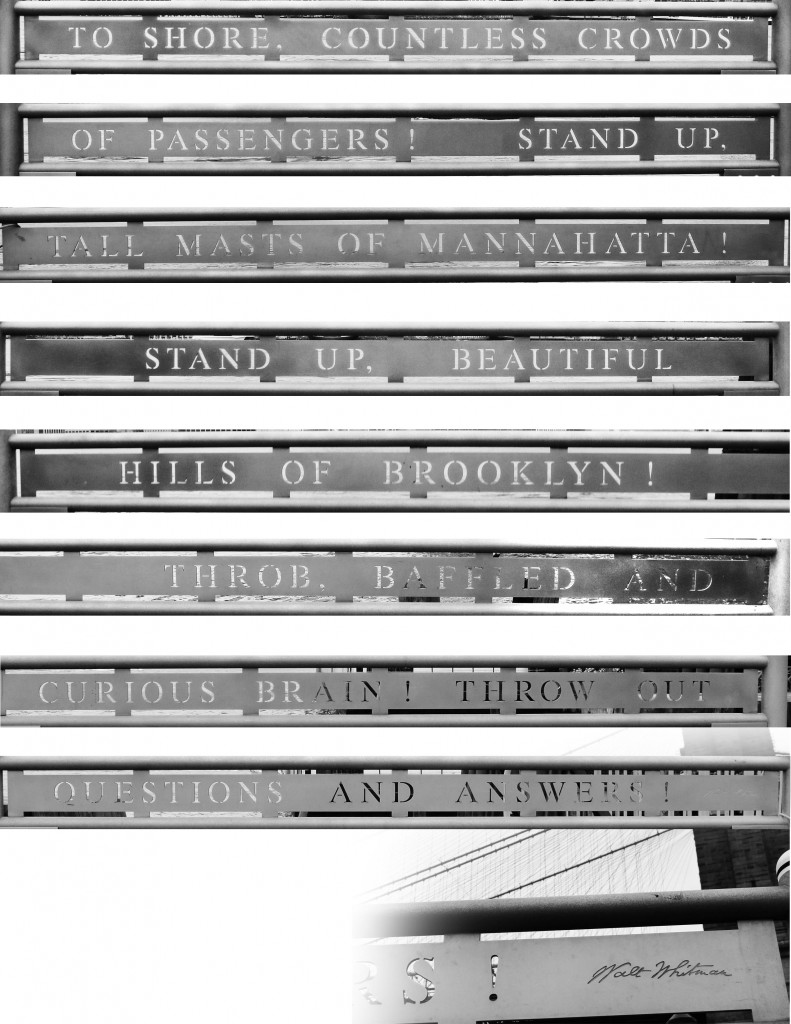
_
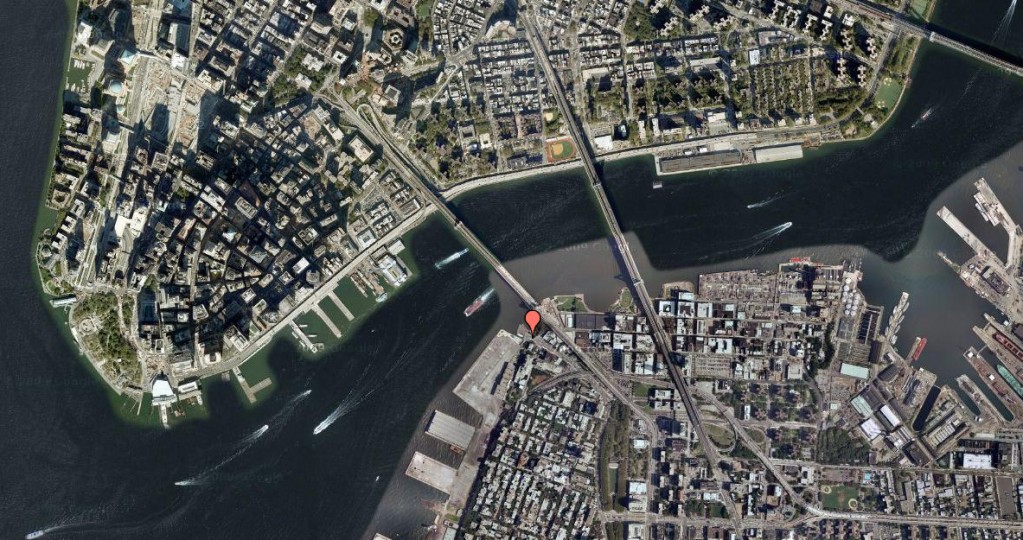
fulton ferry landing by google
_
These passages from Walt Whitman are carved in the hand-railing of the Fulton Ferry Landing pier.
While I was standing at the pier and looking out at Manhattan, I could still imagine, how it might have had been in early 1800. The crowd of tourists visiting the space and creating “chaos” who is going to take the best spot to take a picture. Reading the passages from Whitman
Cross from shore to shore,
Countless crowds of passengers!
We experience this everyday in the subways, or buses, where everyone is rushing to go somewhere. Whitman liked riding with ferry because it made him interact with people more.
field trip_fulton ferry landing
flow on, river! flow
with the flood-tide. and
ebb with ebb-tide!
frolic on, crested and
scallop-edg’d waves!
gorgeous clouds of the
sunset! drench with your
splendor me, or the men
and women generations
after me! cross from shore
to shore, countless crowds
of passengers! stand up,
tall masts of mannahatta!
stand up, beautiful
hills of brooklyn!
throb, baffled and
curious brain! throw out
questions and answers!
-walt whitman-



_

fulton ferry landing by google
_
These passages from Walt Whitman are carved in the hand-railing of the Fulton Ferry Landing pier.
While I was standing at the pier and looking out at Manhattan, I could still imagine, how it might have had been in early 1800. The crowd of tourists visiting the space and creating “chaos” who is going to take the best spot to take a picture. Reading the passages from Whitman
Cross from shore to shore,
Countless crowds of passengers!
We experience this everyday in the subways, or buses, where everyone is rushing to go somewhere. Whitman liked riding with ferry because it made him interact with people more.
A Pumpkin for Whitman
This week we made our way across Camden to Harleigh Cemetery, the site of Whitman’s mausoleum. As we drove through Camden (and got a little mixed up along the way), we were surrounded by what we have come to know as being very typical of this city. Let’s just say it’s far from the bustling Brooklyn-esque environment Whitman once called home.
Turning into Harleigh, however, is like turning into a completely different place and time. The cemetery is spacious and clean, natural and seemingly untainted by the city that surrounds it. Made all the more beautiful by the falling leaves and perfect autumn temperatures, the view from Whitman’s resting place is nothing but ideal.
I had seen pictures of the tomb in books before arriving there on Wednesday, so the appearance of Whitman’s grand design was not surprising. Against the background of gray stone and dead brown leaves, though, was a quaint little pumpkin, resting comfortably against the memorial that features Whitman’s image.

The pumpkin, not the monument, was actually the first thing that I noticed as we approached. It probably stood out simply because of its color, but the pumpkin, I think, speaks volumes about Whitman’s effect on the average American today. Although he rests here in the heart of a city that, many would argue, is far from his image of a unified America, someone decided Whitman might like a little pumpkin for the fall. It’s not large and gaudy, just a little color and charm.
The little pumpkin is an acknowledgement of Whitman’s relevance today in Camden and in America. It, as well as the flowers left at the gate, are symbols of our attempts to give back to the old bard who gave America so much. Some of us give by dedicating hours to scholarly work or academic blogs; others buy pumpkins. Even in death, Whitman’s goal of appealing to the American masses seems not only fulfilled, but ongoing.
A Pumpkin for Whitman
This week we made our way across Camden to Harleigh Cemetery, the site of Whitman’s mausoleum. As we drove through Camden (and got a little mixed up along the way), we were surrounded by what we have come to know as being very typical of this city. Let’s just say it’s far from the bustling Brooklyn-esque environment Whitman once called home.
Turning into Harleigh, however, is like turning into a completely different place and time. The cemetery is spacious and clean, natural and seemingly untainted by the city that surrounds it. Made all the more beautiful by the falling leaves and perfect autumn temperatures, the view from Whitman’s resting place is nothing but ideal.
I had seen pictures of the tomb in books before arriving there on Wednesday, so the appearance of Whitman’s grand design was not surprising. Against the background of gray stone and dead brown leaves, though, was a quaint little pumpkin, resting comfortably against the memorial that features Whitman’s image.

The pumpkin, not the monument, was actually the first thing that I noticed as we approached. It probably stood out simply because of its color, but the pumpkin, I think, speaks volumes about Whitman’s effect on the average American today. Although he rests here in the heart of a city that, many would argue, is far from his image of a unified America, someone decided Whitman might like a little pumpkin for the fall. It’s not large and gaudy, just a little color and charm.
The little pumpkin is an acknowledgement of Whitman’s relevance today in Camden and in America. It, as well as the flowers left at the gate, are symbols of our attempts to give back to the old bard who gave America so much. Some of us give by dedicating hours to scholarly work or academic blogs; others buy pumpkins. Even in death, Whitman’s goal of appealing to the American masses seems not only fulfilled, but ongoing.